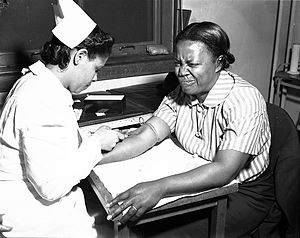Soreness
| Pain | |
|---|---|
 |
|
| A woman grimacing while having blood drawn | |
| Classification and external resources | |
| Specialty | Neurology |
| ICD-10 | R52 |
| ICD-9-CM | 338 |
| DiseasesDB | 9503 |
| MedlinePlus | 002164 |
| MeSH | D010146 |
Pain is a distressing feeling often caused by intense or damaging stimuli. The International Association for the Study of Pain's widely used definition defines pain as "an unpleasant sensory and emotional experience associated with actual or potential tissue damage, or described in terms of such damage"; however, due to it being a complex, subjective phenomenon, defining pain has been a challenge. In medical diagnosis, pain is regarded as a symptom of an underlying condition.
Pain motivates the individual to withdraw from damaging situations, to protect a damaged body part while it heals, and to avoid similar experiences in the future. Most pain resolves once the noxious stimulus is removed and the body has healed, but it may persist despite removal of the stimulus and apparent healing of the body. Sometimes pain arises in the absence of any detectable stimulus, damage or disease.
Pain is the most common reason for physician consultation in most developed countries. It is a major symptom in many medical conditions, and can interfere with a person's quality of life and general functioning. Simple pain medications are useful in 20% to 70% of cases. Psychological factors such as social support, hypnotic suggestion, excitement, or distraction can significantly affect pain's intensity or unpleasantness. In some debates regarding physician-assisted suicide or euthanasia, pain has been used as an argument to permit people who are terminally ill to end their lives.
In 1994, responding to the need for a more useful system for describing chronic pain, the International Association for the Study of Pain (IASP) classified pain according to specific characteristics:
However, this system has been criticized by Clifford J. Woolf and others as inadequate for guiding research and treatment. Woolf suggests three classes of pain:
Pain is usually transitory, lasting only until the noxious stimulus is removed or the underlying damage or pathology has healed, but some painful conditions, such as rheumatoid arthritis, peripheral neuropathy, cancer and idiopathic pain, may persist for years. Pain that lasts a long time is called chronic or persistent, and pain that resolves quickly is called acute. Traditionally, the distinction between acute and chronic pain has relied upon an arbitrary interval of time from onset; the two most commonly used markers being 3 months and 6 months since the onset of pain, though some theorists and researchers have placed the transition from acute to chronic pain at 12 months. Others apply acute to pain that lasts less than 30 days, chronic to pain of more than six months' duration, and subacute to pain that lasts from one to six months. A popular alternative definition of chronic pain, involving no arbitrarily fixed durations, is "pain that extends beyond the expected period of healing". Chronic pain may be classified as cancer pain or else as benign.
...
Wikipedia
